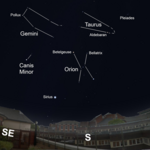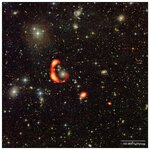Space

I'm not all that excited about manned missions in space because it is a struggle for NASA to even build a space telescope without going 13 years over budget, but it's worth doing basic research on how an outpost on Luna might be built.
It will require a lot of multi-purposing, and re-purposing.
A new paper says there is an interesting way to even repurpose astronaut pee. Urea could be used as a plasticizer in the concrete of the structures, to make it easier to work with before it sets. And we will need structures. Lawyers are queuing up to sue cell phone companies over 5G service,…

640 light-years away in the constellation of Pisces is a planet where the day side temperature exceeds 4,300 degrees Fahrenheit, hot enough enough to vaporize metal.
And it does. Then, on planet tidally locked planet WASP-76b, winds carry the vapor to the cooler permanent night side, where the iron turns into rain.
Like our Moon on its orbit around Earth, WASP-76b is tidally locked. It takes as long to rotate around its axis as it does to go around its star so the day side receives thousands of times more radiation from its parent star than the Earth does from the Sun. It's so…

A new paper reports again about the successful cultivation of red romaine lettuce, Lactuca sativa cv ‘Outredgeous’ plants from surface-sterilized seeds grown in Vegetable Production Systems growth chambers on the International Space Station during the years 2014 to 2016.
Unlike what you'll get in Chipotle, this lettuce is free of disease-causing microbes and safe to eat.
We're not worried about growing food in space any time soon when we can't even launch a telescope without a generation of delays and $10 billion in cost overruns but this is good proof-of-concept. Astronauts eat just…

The Chang'E-4 mission (CE-4) landed on the eastern floor of the Van Kármán crater, near the Moon's south pole, on Jan. 3, 2019. It deployed its Yutu-2 rover, which uses Lunar Penetrating Radar (LPR) to investigate the underground it roams and found that the subsurface at the CE-4 landing site is much more transparent to radio waves.
Due to that, radio signals reached a depth of 40 meters using a 500 MHz frequency - more than three times the depth previously reached by CE-3. This data allowed the researchers to develop an approximate image of the subsurface stratigraphy.
The researchers…

NGC 4490, nicknamed the "Cocoon Galaxy" because of its shape, has "a clear double nucleus structure," according to a new paper.
It's only realized now because while one nucleus can be seen in optical wavelengths, the other is hidden in dust and can only be seen in infrared and radio wavelengths.
The work started when first author Allen Lawrence was taking undergraduate astronomy classes at the University of Wisconsin-Madison. He had the chance to study one of two galaxy systems and picked NGC 4490, which is interacting with a smaller galaxy, NGC 4485. The system is about 20 percent of…
A burst of gravitational waves followed closely by neutrinos and then the light. While light's speed, in vacuum, is constant in all inertial reference frames, it does vary depending on the medium. The same is not necessarily true of all waves which share this quality with light. Neutrinos and gravitational waves would reach us well before the light did. This is why the widely reported news of LIGO detecting a burst of gravitational waves is so intriguing to astrophysicists. Here is what else the astrophysical community will be looking for and why.…

Every season has its characteristic star constellations in the night sky. Orion – one of the most recognizable – is distinctly visible on crisp, clear winter nights in the northern hemisphere. The constellation is easy to spot even in light-polluted cities, with its bright stars representing the shape of a person.
Betelgeuse, marking Orion’s top left shoulder, is often its brightest star. Red in color, this star is usually the 12th brightest in the entire sky. But it has recently dimmed dramatically to an all time low of 21st brightest star in the sky. As a result, many have started…

A ring of hydrogen gas with a diameter of 380,000 light-years- 4 times that of our Milky Way - has been discovered shrouding the galaxy named AGC 203001, 260 million light-years away from us.
Neutral hydrogen emits radio waves at a wavelength of about 21cm. This radiation from neutral hydrogen atoms has allowed radio astronomers to map the amount and distribution of neutral hydrogen gas in our Milky Way galaxy and in other galaxies in the Universe. Typically, large reservoirs of neutral hydrogen gas are found in galaxies which are actively forming new stars. However, despite…

Our bizarre solar system has no hot Jupiter. XO-7 b is a hot Jupiter which orbits its star once roughly every 3 days (1). Of all the solar systems in the heavens ours seems to be most unusual. Our solar system has orderly circular orbits, with rocky planets near the Sun, and gassy icy planets farther out. That order and stability seems to be the exception not the rule. Humanity has now observed numerous solar systems and found one type to be very common. A solar system which contains a hot Jupiter like planet orbiting much closer to the star than…

This is the latest of several articles I've done about NASA / ESA’s plan to return a sample from Mars. The samples would be geological ones, but they also could contain life indeed NASA motivate the mission by the possibility of life, especially past life but present day life can't be ruled out. This means it could lead to extraterrestrial life coming into contact with Earth's biosphere. That leads to the question - what are NASA or ESA doing to prepare the planetary protection procedures and the supporting environmental legislation for a sample return? They would not be permitted to just…